 W
WThe Abell catalogue is a catalogue of approximately 4,000 galaxy clusters with at least 30 members, almost complete to a redshift of z = 0.2. It was originally compiled by the American astronomer George O. Abell in 1958 using plates from POSS, and extended to the southern hemisphere by Abell, Corwin and Olowin in 1987. The name "Abell" is also commonly used as a designation for objects he compiled in a catalogue of 86 planetary nebulae in 1966. The proper designation for the galaxy clusters is ACO, as in "ACO 13", while the planetary-nebula designation is the single letter A, as in "A 39".
 W
WThe Abell catalog of rich clusters of galaxies is an all-sky catalog of 4,073 rich galaxy clusters of nominal redshift z ≤ 0.2. This catalog supplements a revision of George O. Abell's original "Northern Survey" of 1958, which had only 2,712 clusters, with a further 1,361 clusters – the "Southern Survey" of 1989, published after Abell's death by co-authors Harold G. Corwin and Ronald P. Olowin from those parts of the south celestial hemisphere that had been omitted from the earlier survey.
 W
WAbell 262 is a galaxy cluster in the Abell catalogue. It is part of the Perseus-Pisces Supercluster, one of the largest known structures in the universe. Although its central galaxy, NGC 708, is a giant cD galaxy, most of its bright galaxies are spirals, which is unusual for a galaxy cluster. With approximately 200 members it is a comparatively small cluster.
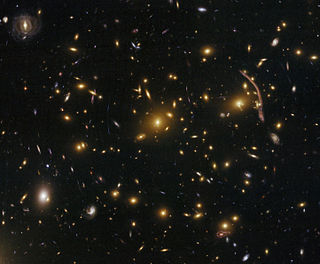 W
WAbell 370 is a galaxy cluster located approximately 4 billion light-years away from the Earth, in the constellation Cetus. Its core is made up of several hundred galaxies. It was catalogued by George Abell, and is the most distant of the clusters he catalogued.
 W
WAbell 383 is a galaxy cluster in the Abell catalogue.
 W
WAbell 400 is a galaxy cluster which contains the galaxy NGC 1128 with two supermassive black holes spiraling towards merger.
 W
WThe Perseus cluster is a cluster of galaxies in the constellation Perseus. It has a recession speed of 5,366 km/s and a diameter of 863′. It is one of the most massive objects in the known universe, containing thousands of galaxies immersed in a vast cloud of multimillion-degree gas.
 W
WThe Abell 520 galaxy cluster possesses an unusual substructure resulting from a major merger. It has been popularly nicknamed The Train Wreck Cluster, due to its chaotic structure, and is classified as a Bautz-Morgan type III cluster. It is at a co-moving radial distance of 811 Mpc (2,645 Mly) and subtends 25 arcminutes on the sky. Analysis of the motions of 293 galaxies in the cluster field suggested that Abell 520 was a cluster forming at the crossing of three filaments of the large scale structure
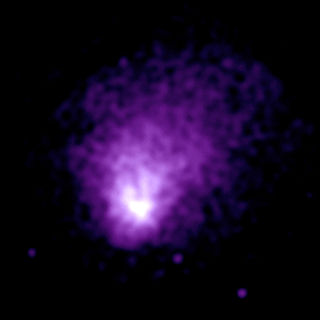 W
WAbell 665 is a galaxy cluster in the Abell catalogue in the constellation Ursa Major. It is also known as the only cluster in his 1989 catalog to receive Abell's highest richness class of 5. This means that it contains at least 300 galaxies in the magnitude range of m3 to m3+2, where m3 is the magnitude of the third-brightest member of the cluster. The clusters in all other richness classes contain less than 300 such galaxies. Abell 665's combination of high brightness and large distance, made it an excellent candidate along with 37 other clusters to help determine the Hubble constant using the Sunyaev–Zel'dovich effect in 2006.
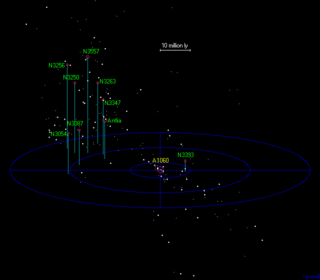 W
WThe Hydra Cluster is a galaxy cluster that contains 157 bright galaxies, appearing in the constellation Hydra. The cluster spans about ten million light-years and has an unusually high proportion of dark matter. The cluster is part of the Hydra-Centaurus Supercluster located 158 million light-years from Earth. The cluster's largest galaxies are elliptical galaxies NGC 3309 and NGC 3311 and the spiral galaxy NGC 3312 all having a diameter of about 150,000 light-years. In spite of a nearly circular appearance on the sky, there is evidence in the galaxy velocities for a clumpy, three-dimensional distribution.
 W
WAbell 1185 is a galaxy cluster located in the constellation Ursa Major. It is approximately 400 million light-years away from Earth and spans one million light-years across. It is a member of the Leo Supercluster. One of its brightest galaxies is NGC 3550.
 W
WAbell 1413 is a galaxy cluster in the Abell catalogue. The Abell catalogue was published by George O. Abell in 1958 while working on his PhD at California Institute of Technology. The catalogue has two different surveys. The Northern survey was done first by Abell in 1958 with the help of A.G. Wilson. The Northern Survey has 2,712 clusters, and in order for a cluster to be put into the catalogue it must pass four criteria. The first criterion is richness, and Abell divided the clusters into 6 different richness groups. Group 0 was 30-49 galaxies, Group 1 was 50-79 galaxies, Group 2 was 80-129 galaxies, Group 3 was 130 to 199 galaxies, Group 4 was 200-299 galaxies, and Group 5 was more than 299 galaxies. The second criterion was compactness. To meet this requirement a cluster must have 50 or more members in one counting radius of the cluster's center. The third criterion is distance. A cluster must have a nominal redshift between .02 and .2, which means a recessional velocity is between 6,000 and 60,000 km/s. The fourth and final criterion was galactic latitude. Areas around the milky way were excluded because it was difficult to identify galaxy clusters. The Southern survey was done in 1989 and added 1,361 clusters using the same criteria as the Northern Survey.
 W
WThe Coma Cluster is a large cluster of galaxies that contains over 1,000 identified galaxies. Along with the Leo Cluster, it is one of the two major clusters comprising the Coma Supercluster. It is located in and takes its name from the constellation Coma Berenices.
 W
WAbell 1689 is a galaxy cluster in the constellation Virgo nearly 2.2 billion light-years away.
 W
WAbell 1835 is a galaxy cluster in the Abell catalogue. It is a cluster that also gravitational lenses more-distant background galaxies to make them visible to astronomers. The cluster has a red shift of around 75,900 km/s and spans 12′.
 W
WAbell 2029 or A2029 is a large cluster of galaxies 315 megaparsecs away in the constellation Virgo. A2029 is a Bautz–Morgan classification type I cluster due to its large central galaxy, IC 1101. Abell 2029 has a diameter of 5.8–8 million light-years. This type of galaxy is called a cD-type brightest cluster galaxy and may have grown to its large size by accreting nearby galaxies. Despite its relaxed state, it is the central member of a large supercluster which shows clear signs of interaction.
 W
WAbell 2065 is a highly concentrated galaxy cluster in the constellation of Corona Borealis containing over 400 member galaxies, the brightest of which are 16th magnitude. The cluster is more than one billion light-years from Earth. On a larger scale still, Abell 2065, along with Abell 2061, Abell 2067, Abell 2079, Abell 2089, and Abell 2092, make up the Corona Borealis Supercluster.
 W
WAbell 2142, or A2142, is a huge, X-ray luminous galaxy cluster in the constellation Corona Borealis. It is the result of a still ongoing merger between two galaxy clusters. The combined cluster is six million light years across, contains hundreds of galaxies and enough gas to make a thousand more. It is "one of the most massive objects in the universe."
 W
WAbell 2147 is a galaxy cluster in the Abell catalogue. It is located within the core of the Hercules Superclusters, within Serpens Caput, near the cluster Abell 2152, approximately two degrees south southwest of the Hercules Cluster. It is possible that Abell 2147 is actually part of the Hercules Cluster considering that it shares the same redshift of 550 million light years.
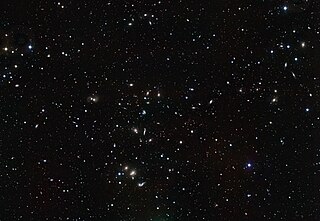 W
WThe Hercules Cluster is a cluster of about 200 galaxies some 500 million light-years distant in the constellation Hercules. It is rich in spiral galaxies and shows many interacting galaxies. The cluster is part of the larger Hercules Supercluster, which is itself part of the much larger Great Wall super-structure.
 W
WAbell 2163 is one of the richest and most distant of the clusters of galaxies found in the Abell catalogue. Its abell richness class is 2 and position is at a redshift z=0.2. Data from Chandra X-ray Observatory have shown that it is the hottest galaxy cluster in the Abell catalogue. It is also a merging cluster.
 W
WAbell 2199 is a galaxy cluster in the Abell catalogue featuring a brightest cluster galaxy NGC 6166, a cD galaxy. Abell 2199 is the definition of a Bautz-Morgan type I cluster due to NGC 6166.
 W
WAbell 2218 is a cluster of galaxies about 2 billion light-years away in the constellation Draco.
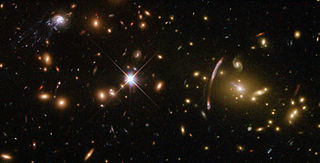 W
WAbell 2667 is a galaxy cluster. It is one of the most luminous galaxy clusters in the X-ray waveband known at a redshift about 0.2.
 W
WAbell 2744, nicknamed Pandora's Cluster, is a giant galaxy cluster resulting from the simultaneous pile-up of at least four separate, smaller galaxy clusters that took place over a span of 350 million years. The galaxies in the cluster make up less than five percent of its mass. The gas is so hot that it shines only in X-rays. Dark matter makes up around 75 percent of the cluster's mass.
 W
WThe Centaurus Cluster (A3526) is a cluster of hundreds of galaxies, located approximately 170 million light years away in the Centaurus constellation. The brightest member galaxy is the elliptical galaxy NGC 4696 (~11m). The Centaurus cluster shares its supercluster, the Hydra-Centaurus Supercluster, with IC4329 Cluster and Hydra Cluster.
 W
WThe Norma Cluster (ACO 3627 or Abell 3627) is a rich cluster of galaxies located near the center of the Great Attractor; it is about 68 Mpc (222 Mly) distant. Although it is both nearby and bright, it is difficult to observe because it is located in the Zone of Avoidance, a region near the plane of the Milky Way. Consequently, the cluster is severely obscured by interstellar dust at optical wavelengths. Its mass is estimated to be on the order of 1015 solar masses.
 W
WThe Fornax Cluster is a cluster of galaxies lying at a distance of 19 megaparsecs. It is the second richest galaxy cluster within 100 million light-years, after the considerably larger Virgo Cluster, and may be associated with the nearby Eridanus Group. It lies primarily in the constellation Fornax, with its southern boundaries partially crossing into the constellation of Eridanus, and covers an area of sky about 6° across or about 28 sq degrees.
 W
WThe Antlia Cluster is a cluster of galaxies located in the Hydra-Centaurus Supercluster. The Antlia Cluster is the third-nearest to the Local Group after the Virgo Cluster and Fornax Cluster. Antlia's distance from Earth is 40.5 megaparsecs to 40.9 Mpc (133.4 Mly) and can be viewed from Earth in the constellation Antlia. The Antlia Cluster should not be confused with the Antlia Dwarf galaxy.
 W
WThe Abell S740 is a cluster of galaxies identified in the Abell catalogue of southern rich clusters of galaxies. It is over 450 Mly away in the constellation Centaurus. It has a redshift of 10,073 km/s.